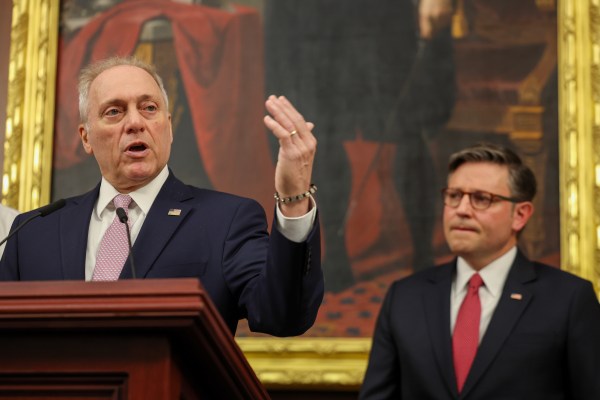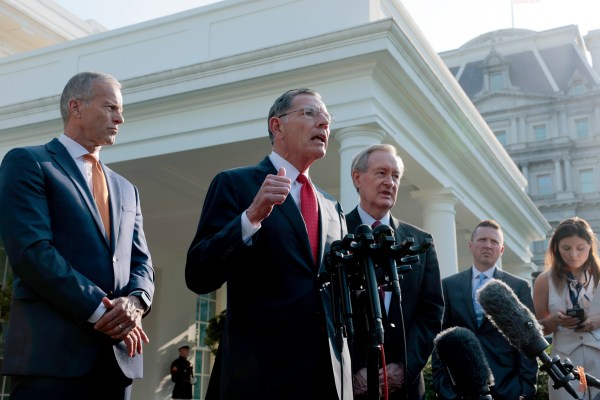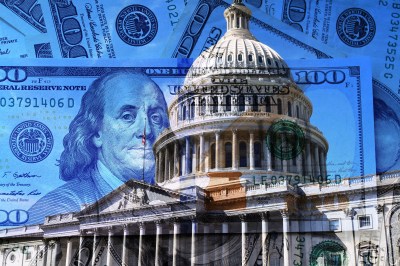Republicans vociferously claim their tax legislation—the One Big Beautiful Bill Act passed by the House and working its way through the Senate—would unleash an economic boom so colossal that its resulting tax revenues would offset the entire cost. This dubious boast was shredded by a recent Congressional Budget Office (CBO) reality check showing that the bill’s broader economic effects actually increase the 10-year cost projection by $356 billion.
According to this “dynamic score,” the bill is so poorly designed that it would fail to produce any significant long-term increase in economic growth. Instead, the tiny amount of growth revenues would be swallowed by $441 billion in added 10-year federal debt interest costs that would result from the bill raising interest rates across the economy and on the entire federal debt. Those “dynamic” interest costs from rising rates are in addition to $551 billion in interest costs that would be paid specifically on the bill’s $2.4 trillion in 10-year borrowing.
Rather than address the bill’s extraordinary cost, Republicans responded by attacking the CBO. They challenged the agency’s historical accuracy by claiming that it failed to competently score the 2017 Tax Cuts and Jobs Act (TCJA)–even as CBO’s subsequent revenue estimate achieved 99.5 percent accuracy up until the pandemic. President Donald Trump accused the CBO of being run by Democrats even though its director is a Republican. Sen. Tim Scott produced a video claiming that CBO also erroneously scored tax cuts in the 1930s and 1960s—which is impossible because CBO did not exist until 1974, not to mention that those 1930s tax cuts actually took place in the 1920s. All because the CBO refused to pretend that the House Republican tax bill would pay for itself or even offset a portion of the cost.
A more serious political party would have acknowledged that CBO’s analysis aligned with virtually all tax modeling organizations on the left and right—including the conservative Tax Foundation—and then committed itself to fixing the bill. Instead, Republican economic policy in 2025 is much like Democratic economic policy under President Joe Biden: lazy special-interest pandering combined with an almost mystical belief in an economic nirvana that never arrives.
Tax relief becomes a religion.
The Laffer curve, a theoretical construct favored by supply-side economists, observes that tax revenues will peak at a tax rate somewhere above 0 percent but below 100 percent. In cases where the tax rates exceed the revenue-maximizing rate, a tax rate reduction will increase revenues by encouraging an expansion of taxable economic activity that is substantial enough to outweigh the losses from the reduced tax rate. More broadly, supply-side economists note that, in certain situations, certain tax reductions can expand the economy by increasing incentives to work, save, invest, and be productive. The resulting additional tax revenues can offset a modest portion of the tax cut cost.
Today’s Republicans have parodied the Laffer curve into a religious belief that is totally divorced from economic reality. They treat nearly all tax reductions as magically igniting economic expansions vast enough to increase total tax revenues. Sen. Scott summarizes in the aforementioned video that, “The Laffer curve is right. If you lower taxes, you increase production, and that means more revenue for the government. It always has worked. I think it always will work.” That is definitely not how the Laffer curve or tax policy works, as even conservative economists will confirm.
Neither the 1980s Reagan tax cuts, 2001 Bush tax cuts, nor 2017 Trump tax cuts came close to paying for themselves in increased tax revenues from economic growth. That is because the vast majority of tax rates are already well below the peak rate of the Laffer curve. Current lawmakers are not rescuing taxpayers from (non-existent) 70 percent tax brackets that had been losing revenues, but instead focusing on adding new carve-outs and trimming marginal tax brackets from, say, 25 percent to 23 percent.
“A more serious political party would have acknowledged that CBO’s analysis aligned with virtually all tax modeling organizations on the left and right—including the conservative Tax Foundation—and then committed itself to fixing the bill.”
At the typical marginal tax rate of 20 percent, every $1 tax cut would need to produce $5 in additional GDP (subsequently taxed at 20 percent) to recover that dollar of tax revenue and thus pay for itself. Some growth may result, but a 500 percent economic return and resulting 100 percent tax revenue return is extraordinarily rare.
Not all tax cuts are created equal. Mathematically, economic growth equals productivity growth (more output per hour worked) times labor force growth (more aggregate hours worked). If a policy does not increase labor supply (i.e., more workers or more average hours worked) or provide additional tools for labor productivity (i.e., better technology, innovation, business investment, education, or job training) then it will not contribute to long-term economic growth.
By contrast, tax cuts do not aid the economy by “putting money in people’s pockets,” which is just the flip side of the argument that government spending creates economic growth, an argument conservatives rightly dismiss. In fiscal policy, the amount of money entering Washington from taxes and borrowing will equal the amount departing Washington in spending. So giving a family a $100 tax reduction must result in a corresponding $100 reduction in government spending or $100 in new government borrowing out of the private sector. Either way, the family’s $100 in additional spending power is offset by someone else having $100 less to spend. Smart tax cuts grow the long-term economy because they encourage labor supply and/or productivity, not because they give people “money to spend.”
Of course, enacting tax legislation has always required balancing pro-growth provisions such as marginal tax rate reductions and investment incentives with more popular tax giveaways such as tax rebates and child tax credits. The tax reformers who drafted the 2017 TCJA were originally motivated to modernize a fossilized, 1960s corporate tax code that even Democratic leaders quietly agreed had become a global outlier sabotaging American competitiveness. But because most voters may not appreciate corporate tax policy’s vital role in American economic competitiveness, those reforms had to be buried beneath the candy of individual tax relief. These individual tax changes had some merit—slightly lower tax rates and modest simplification—however, they were generally not considered economic game-changers, despite their larger cost.
Populist pandering preempts prosperity.
Today’s Republican policymaking no longer buries much economic nourishment underneath the populist candy. The longstanding goals of pro-growth tax reform and simplification—broaden the base and lower the rates—have given way to endless special interest carve-outs for various voting blocs. Nevertheless, in the new Laffer curve religion, virtually any policy that reduces a tax is declared to have magical economy-boosting powers. Like Brawndo, all tax cuts apparently have electrolytes. It’s what economies crave (just watch the documentary Idiocracy to understand the current political moment).
The House and Senate tax bills are largely devoid of pro-growth tax relief and simplification. Giving an expensive handout to seniors (by increasing their standard deduction) does nothing to encourage working, saving, investing, or productivity. Ending taxes on tips inexplicably hands a special interest carve-out to servers without benefiting the restaurant’s hostesses and cooks. Ending overtime taxes will invite more tax gaming than boosted work hours. More child tax credits may serve social goals but are economically indistinguishable from a welfare payment. Enlarging the deduction for state and local taxes (SALT) is a vote-buying giveaway to coastal Republicans that does not expand investment or productivity. Expanding the small business tax deduction has not produced enough economic benefits to justify the cost.
None of these expensive tax policies will benefit the economy significantly. And the largest component of the tax bill—renewing and extending the TCJA—could not possibly produce a historic economic surge because it merely maintains current tax policies (perhaps it could prevent a quite small slowdown that expiration would bring). Overall, any modest economic bump is likely to be obliterated by the GOP’s steep tariffs, $2 trillion budget deficits, and immigration restrictions that starve a labor force that is already slowing toward zero growth. Against all those headwinds, claiming that a few special interest tax carve-outs will produce the most impressive economic boom in three decades is simply delusional.
The most pro-growth TCJA provisions up for renewal are the tax incentives for business investment as well as for research and development. Economic modelers have shown that such policies substantially assist capital formation, innovation, and economic growth. And yet, inexplicably, they are among the few policies where Republicans decided to cut corners by extending them only through 2029. This expiration is one of the two central reasons why tax modelers agree that the bill will not improve long-term growth.
The other economic saboteur is the staggering cost—currently $3 trillion over the decade including interest, which likely swells past $5 trillion if most of the fake expiration dates and spending offsets do not survive Senate consideration. On top of Washington’s already-massive deficits, this bill could ultimately cost more than the 2017 TCJA, 2020 CARES Act (pandemic relief), and 2021 American Rescue Plan—combined. Together with rising interest costs and Social Security and Medicare’s deepening shortfalls, the federal debt held by the public—just under $30 trillion today—would likely double to $60 trillion within a decade.
A federal debt escalating this rapidly will stretch bond markets and hike interest rates on mortgages, car loans, and business investments. Those interest rates will also cost Washington hundreds of billions of dollars in additional interest costs, and starve the economy of the investments needed to innovate, grow businesses, and raise wages. This is why the Yale Budget Lab projects that the House bill’s long-term impact on economic growth will be negative.
The politics of policy exhaustion.
Republicans have seemingly surrendered on using tax policy to encourage economic efficiency and prosperity. Instead, they have reduced tax legislation to a nakedly political exercise of handing out benefits to carved-up constituencies such as seniors, farmers, and business owners, and then simply buying the votes of coastal Republican lawmakers with SALT handouts. The tragedy becomes farce when noting that this pander fest has achieved just 29 percent support from voters. It takes special skill to design a tax cut that eschews efficiency for popularity and winds up with neither.
Republican lawmakers have dug themselves a hole. After ignoring economic considerations when crafting the bill, they now need that economic boom and its growth revenues to quell the growing voter concerns over the exorbitant cost. Yet, disappointingly, GOP leaders have dismissed the public’s economic and fiscal concerns as merely a messaging challenge rather than a legitimate policy challenge. They chose more spin over better substance.
And the spin is not working. In past tax relief battles, Republicans could count on conservative think tanks like the American Enterprise Institute, Tax Foundation, and Heritage Foundation to supply economic modeling, factoids, and key data nuggets to defend their policies. This time around, however, the exorbitant cost and poor design of the GOP tax cuts have brought widespread criticism even among the conservative economic intelligentsia. This has left Republicans to fight a tax cut messaging war without the usual think tank ammunition.
“Washington Republicans have essentially given up on reining in runaway debt. They have given up on rescuing Social Security and Medicare from insolvency. They have given up on innovative free market solutions to health care, energy, and infrastructure. … They have surrendered trade policy to the White House, foreign policy to the executive branch, and spending reforms to DOGE.”
Without credible analysis to defend their legislation, many elected Republicans have veered into wild and unsupported claims about tax cuts paying for themselves and “the establishment” (which presumably includes leading conservative organizations) plotting against Republicans. They have ordered the congressional Joint Committee on Taxation to score a $4 trillion tax cut as revenue-neutral. They have nonsensically attacked the CBO with false claims about its accuracy. President Trump and congressional Republicans have even spread false data, such as claiming that a 68 percent tax hike awaits families if the TCJA expires.
Washington Republicans govern increasingly like Democrats. It was just four years ago that Biden turned the $1.9 trillion American Rescue Plan “stimulus” into yet another “coalition politics” bonanza of handouts to various Democratic constituencies. Democrats clung to a stale and exaggerated economic framework (Keynesianism) to claim that such handouts would stimulate an economic boom. When inflation soared past 9 percent instead, Democratic leaders treated this economic crisis as a mere messaging problem to spin with empty talking points (remember “greedflation,” “transitory,” and “Putin’s price hike”) rather than with better economic policies. Ultimately, this political disaster helped cost Democrats control of Washington. The Republicans who replaced them are now running a similar playbook.
This is what policy exhaustion looks like. A decade ago, Republicans were awash in low-cost tax reform blueprints to provide families with a leaner tax code and businesses with global competitiveness. Today, they are fabricating data to justify a lazy package of unaffordable special interest carve-outs. Even much of the modest Medicaid and SNAP spending offsets—in the unlikely event they survive the Senate—are used to finance the bill’s $52 billion bailout of farmers, another GOP voting bloc.
And it’s not just tax policy. Washington Republicans have essentially given up on reining in runaway debt. They have given up on rescuing Social Security and Medicare from insolvency. They have given up on innovative free market solutions to health care, energy, and infrastructure. They have given up on passing regular appropriations bills. They have surrendered trade policy to the White House, foreign policy to the executive branch, and spending reforms to DOGE. It is no longer clear what most congressional Republicans actually do besides serve as a television cheering section for President Trump and troll Democrats on X.
I worked in Republican economic policy for decades and sincerely believe that America needs a serious “grown up” party that thinks bigger than short-term coalitional pandering. An energetic, optimistic, fiscally conservative, free trade, free market party that is willing to confront America’s real economic challenges with forward-thinking solutions that may not fit on a bumper sticker, yet can deliver true prosperity. Politics will always mean compromises that fall short of our ideals, but a party that insists on taking unpopular votes to enact poorly designed economic reforms is committing both political and economic malpractice.
I’ll wrap up with a brief anecdote. In my 24 years in Washington, including six years working in the Senate, I’ve built relationships with dozens of key lawmakers who specialize in economic policy. On several occasions a retiring longtime GOP senator or House member has pulled me aside to confess deep regret for too often choosing lazy political expediency over deficit reduction and true tax reform. While I sympathize with these political deathbed conversions, America needs more courageous, principled, and innovative lawmakers who get economic policy right while still in office. They can start by tearing up their uninspired tax cut bills, extending the TCJA for one year, and then coming back next year with pro-growth, fiscally responsible tax legislation for which they will not have to apologize later.







Please note that we at The Dispatch hold ourselves, our work, and our commenters to a higher standard than other places on the internet. We welcome comments that foster genuine debate or discussion—including comments critical of us or our work—but responses that include ad hominem attacks on fellow Dispatch members or are intended to stoke fear and anger may be moderated.
With your membership, you only have the ability to comment on The Morning Dispatch articles. Consider upgrading to join the conversation everywhere.